Xiaofan Zhang
Celine
Towards Generalist Intelligence in Dentistry: Vision Foundation Models for Oral and Maxillofacial Radiology
Oct 16, 2025Abstract:Oral and maxillofacial radiology plays a vital role in dental healthcare, but radiographic image interpretation is limited by a shortage of trained professionals. While AI approaches have shown promise, existing dental AI systems are restricted by their single-modality focus, task-specific design, and reliance on costly labeled data, hindering their generalization across diverse clinical scenarios. To address these challenges, we introduce DentVFM, the first family of vision foundation models (VFMs) designed for dentistry. DentVFM generates task-agnostic visual representations for a wide range of dental applications and uses self-supervised learning on DentVista, a large curated dental imaging dataset with approximately 1.6 million multi-modal radiographic images from various medical centers. DentVFM includes 2D and 3D variants based on the Vision Transformer (ViT) architecture. To address gaps in dental intelligence assessment and benchmarks, we introduce DentBench, a comprehensive benchmark covering eight dental subspecialties, more diseases, imaging modalities, and a wide geographical distribution. DentVFM shows impressive generalist intelligence, demonstrating robust generalization to diverse dental tasks, such as disease diagnosis, treatment analysis, biomarker identification, and anatomical landmark detection and segmentation. Experimental results indicate DentVFM significantly outperforms supervised, self-supervised, and weakly supervised baselines, offering superior generalization, label efficiency, and scalability. Additionally, DentVFM enables cross-modality diagnostics, providing more reliable results than experienced dentists in situations where conventional imaging is unavailable. DentVFM sets a new paradigm for dental AI, offering a scalable, adaptable, and label-efficient model to improve intelligent dental healthcare and address critical gaps in global oral healthcare.
SAP-Bench: Benchmarking Multimodal Large Language Models in Surgical Action Planning
Jun 08, 2025Abstract:Effective evaluation is critical for driving advancements in MLLM research. The surgical action planning (SAP) task, which aims to generate future action sequences from visual inputs, demands precise and sophisticated analytical capabilities. Unlike mathematical reasoning, surgical decision-making operates in life-critical domains and requires meticulous, verifiable processes to ensure reliability and patient safety. This task demands the ability to distinguish between atomic visual actions and coordinate complex, long-horizon procedures, capabilities that are inadequately evaluated by current benchmarks. To address this gap, we introduce SAP-Bench, a large-scale, high-quality dataset designed to enable multimodal large language models (MLLMs) to perform interpretable surgical action planning. Our SAP-Bench benchmark, derived from the cholecystectomy procedures context with the mean duration of 1137.5s, and introduces temporally-grounded surgical action annotations, comprising the 1,226 clinically validated action clips (mean duration: 68.7s) capturing five fundamental surgical actions across 74 procedures. The dataset provides 1,152 strategically sampled current frames, each paired with the corresponding next action as multimodal analysis anchors. We propose the MLLM-SAP framework that leverages MLLMs to generate next action recommendations from the current surgical scene and natural language instructions, enhanced with injected surgical domain knowledge. To assess our dataset's effectiveness and the broader capabilities of current models, we evaluate seven state-of-the-art MLLMs (e.g., OpenAI-o1, GPT-4o, QwenVL2.5-72B, Claude-3.5-Sonnet, GeminiPro2.5, Step-1o, and GLM-4v) and reveal critical gaps in next action prediction performance.
Elicit and Enhance: Advancing Multimodal Reasoning in Medical Scenarios
May 29, 2025Abstract:Effective clinical decision-making depends on iterative, multimodal reasoning across diverse sources of evidence. The recent emergence of multimodal reasoning models has significantly transformed the landscape of solving complex tasks. Although such models have achieved notable success in mathematics and science, their application to medical domains remains underexplored. In this work, we propose \textit{MedE$^2$}, a two-stage post-training pipeline that elicits and then enhances multimodal reasoning for medical domains. In Stage-I, we fine-tune models using 2,000 text-only data samples containing precisely orchestrated reasoning demonstrations to elicit reasoning behaviors. In Stage-II, we further enhance the model's reasoning capabilities using 1,500 rigorously curated multimodal medical cases, aligning model reasoning outputs with our proposed multimodal medical reasoning preference. Extensive experiments demonstrate the efficacy and reliability of \textit{MedE$^2$} in improving the reasoning performance of medical multimodal models. Notably, models trained with \textit{MedE$^2$} consistently outperform baselines across multiple medical multimodal benchmarks. Additional validation on larger models and under inference-time scaling further confirms the robustness and practical utility of our approach.
DiagnosisArena: Benchmarking Diagnostic Reasoning for Large Language Models
May 20, 2025Abstract:The emergence of groundbreaking large language models capable of performing complex reasoning tasks holds significant promise for addressing various scientific challenges, including those arising in complex clinical scenarios. To enable their safe and effective deployment in real-world healthcare settings, it is urgently necessary to benchmark the diagnostic capabilities of current models systematically. Given the limitations of existing medical benchmarks in evaluating advanced diagnostic reasoning, we present DiagnosisArena, a comprehensive and challenging benchmark designed to rigorously assess professional-level diagnostic competence. DiagnosisArena consists of 1,113 pairs of segmented patient cases and corresponding diagnoses, spanning 28 medical specialties, deriving from clinical case reports published in 10 top-tier medical journals. The benchmark is developed through a meticulous construction pipeline, involving multiple rounds of screening and review by both AI systems and human experts, with thorough checks conducted to prevent data leakage. Our study reveals that even the most advanced reasoning models, o3-mini, o1, and DeepSeek-R1, achieve only 45.82%, 31.09%, and 17.79% accuracy, respectively. This finding highlights a significant generalization bottleneck in current large language models when faced with clinical diagnostic reasoning challenges. Through DiagnosisArena, we aim to drive further advancements in AIs diagnostic reasoning capabilities, enabling more effective solutions for real-world clinical diagnostic challenges. We provide the benchmark and evaluation tools for further research and development https://github.com/SPIRAL-MED/DiagnosisArena.
PathOrchestra: A Comprehensive Foundation Model for Computational Pathology with Over 100 Diverse Clinical-Grade Tasks
Mar 31, 2025Abstract:The complexity and variability inherent in high-resolution pathological images present significant challenges in computational pathology. While pathology foundation models leveraging AI have catalyzed transformative advancements, their development demands large-scale datasets, considerable storage capacity, and substantial computational resources. Furthermore, ensuring their clinical applicability and generalizability requires rigorous validation across a broad spectrum of clinical tasks. Here, we present PathOrchestra, a versatile pathology foundation model trained via self-supervised learning on a dataset comprising 300K pathological slides from 20 tissue and organ types across multiple centers. The model was rigorously evaluated on 112 clinical tasks using a combination of 61 private and 51 public datasets. These tasks encompass digital slide preprocessing, pan-cancer classification, lesion identification, multi-cancer subtype classification, biomarker assessment, gene expression prediction, and the generation of structured reports. PathOrchestra demonstrated exceptional performance across 27,755 WSIs and 9,415,729 ROIs, achieving over 0.950 accuracy in 47 tasks, including pan-cancer classification across various organs, lymphoma subtype diagnosis, and bladder cancer screening. Notably, it is the first model to generate structured reports for high-incidence colorectal cancer and diagnostically complex lymphoma-areas that are infrequently addressed by foundational models but hold immense clinical potential. Overall, PathOrchestra exemplifies the feasibility and efficacy of a large-scale, self-supervised pathology foundation model, validated across a broad range of clinical-grade tasks. Its high accuracy and reduced reliance on extensive data annotation underline its potential for clinical integration, offering a pathway toward more efficient and high-quality medical services.
QDM: Quadtree-Based Region-Adaptive Sparse Diffusion Models for Efficient Image Super-Resolution
Mar 15, 2025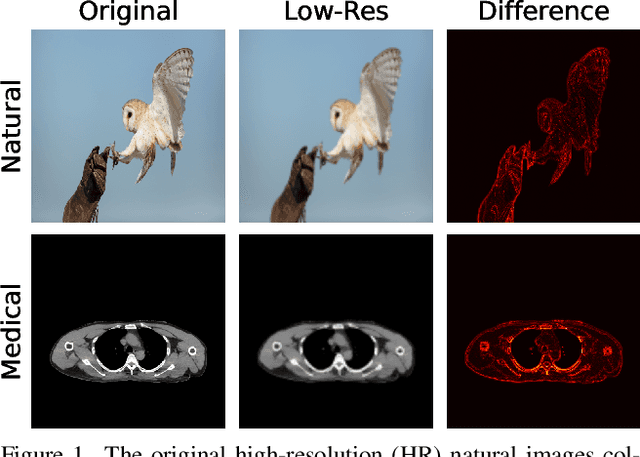
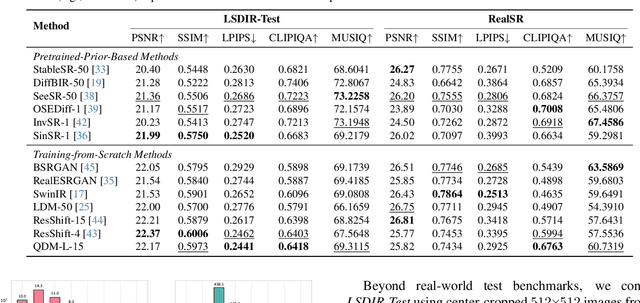

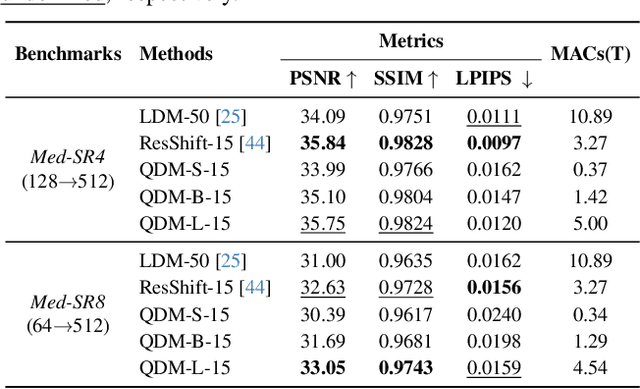
Abstract:Deep learning-based super-resolution (SR) methods often perform pixel-wise computations uniformly across entire images, even in homogeneous regions where high-resolution refinement is redundant. We propose the Quadtree Diffusion Model (QDM), a region-adaptive diffusion framework that leverages a quadtree structure to selectively enhance detail-rich regions while reducing computations in homogeneous areas. By guiding the diffusion with a quadtree derived from the low-quality input, QDM identifies key regions-represented by leaf nodes-where fine detail is essential and applies minimal refinement elsewhere. This mask-guided, two-stream architecture adaptively balances quality and efficiency, producing high-fidelity outputs with low computational redundancy. Experiments demonstrate QDM's effectiveness in high-resolution SR tasks across diverse image types, particularly in medical imaging (e.g., CT scans), where large homogeneous regions are prevalent. Furthermore, QDM outperforms or is comparable to state-of-the-art SR methods on standard benchmarks while significantly reducing computational costs, highlighting its efficiency and suitability for resource-limited environments. Our code is available at https://github.com/linYDTHU/QDM.
Interactive Segmentation and Report Generation for CT Images
Mar 05, 2025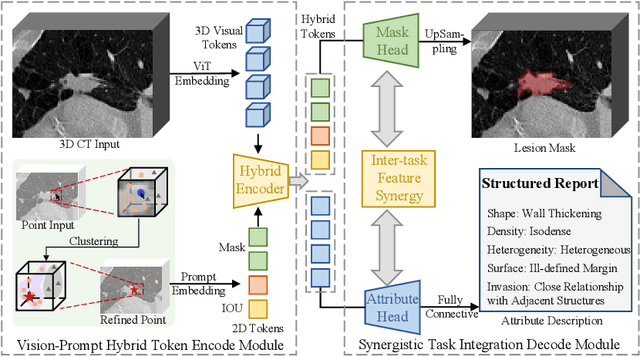
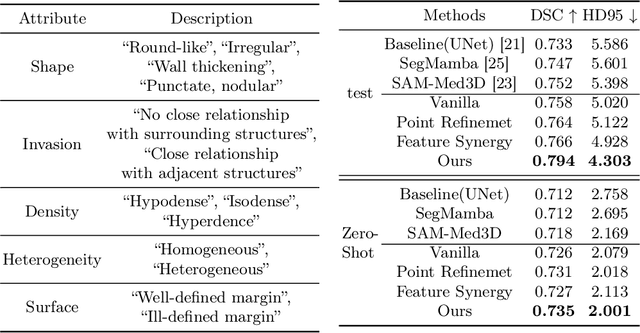


Abstract:Automated CT report generation plays a crucial role in improving diagnostic accuracy and clinical workflow efficiency. However, existing methods lack interpretability and impede patient-clinician understanding, while their static nature restricts radiologists from dynamically adjusting assessments during image review. Inspired by interactive segmentation techniques, we propose a novel interactive framework for 3D lesion morphology reporting that seamlessly generates segmentation masks with comprehensive attribute descriptions, enabling clinicians to generate detailed lesion profiles for enhanced diagnostic assessment. To our best knowledge, we are the first to integrate the interactive segmentation and structured reports in 3D CT medical images. Experimental results across 15 lesion types demonstrate the effectiveness of our approach in providing a more comprehensive and reliable reporting system for lesion segmentation and capturing. The source code will be made publicly available following paper acceptance.
MMXU: A Multi-Modal and Multi-X-ray Understanding Dataset for Disease Progression
Feb 17, 2025Abstract:Large vision-language models (LVLMs) have shown great promise in medical applications, particularly in visual question answering (MedVQA) and diagnosis from medical images. However, existing datasets and models often fail to consider critical aspects of medical diagnostics, such as the integration of historical records and the analysis of disease progression over time. In this paper, we introduce MMXU (Multimodal and MultiX-ray Understanding), a novel dataset for MedVQA that focuses on identifying changes in specific regions between two patient visits. Unlike previous datasets that primarily address single-image questions, MMXU enables multi-image questions, incorporating both current and historical patient data. We demonstrate the limitations of current LVLMs in identifying disease progression on MMXU-\textit{test}, even those that perform well on traditional benchmarks. To address this, we propose a MedRecord-Augmented Generation (MAG) approach, incorporating both global and regional historical records. Our experiments show that integrating historical records significantly enhances diagnostic accuracy by at least 20\%, bridging the gap between current LVLMs and human expert performance. Additionally, we fine-tune models with MAG on MMXU-\textit{dev}, which demonstrates notable improvements. We hope this work could illuminate the avenue of advancing the use of LVLMs in medical diagnostics by emphasizing the importance of historical context in interpreting medical images. Our dataset is released at \href{https://github.com/linjiemu/MMXU}{https://github.com/linjiemu/MMXU}.
A Data-Efficient Pan-Tumor Foundation Model for Oncology CT Interpretation
Feb 10, 2025Abstract:Artificial intelligence-assisted imaging analysis has made substantial strides in tumor diagnosis and management. Here we present PASTA, a pan-tumor CT foundation model that achieves state-of-the-art performance on 45 of 46 representative oncology tasks -- including lesion segmentation, tumor detection in plain CT, tumor staging, survival prediction, structured report generation, and cross-modality transfer learning, significantly outperforming the second-best models on 35 tasks. This remarkable advancement is driven by our development of PASTA-Gen, an innovative synthetic tumor generation framework that produces a comprehensive dataset of 30,000 CT scans with pixel-level annotated lesions and paired structured reports, encompassing malignancies across ten organs and five benign lesion types. By leveraging this rich, high-quality synthetic data, we overcome a longstanding bottleneck in the development of CT foundation models -- specifically, the scarcity of publicly available, high-quality annotated datasets due to privacy constraints and the substantial labor required for scaling precise data annotation. Encouragingly, PASTA demonstrates exceptional data efficiency with promising practical value, markedly improving performance on various tasks with only a small amount of real-world data. The open release of both the synthetic dataset and PASTA foundation model effectively addresses the challenge of data scarcity, thereby advancing oncological research and clinical translation.
O1 Replication Journey -- Part 3: Inference-time Scaling for Medical Reasoning
Jan 11, 2025Abstract:Building upon our previous investigations of O1 replication (Part 1: Journey Learning [Qin et al., 2024] and Part 2: Distillation [Huang et al., 2024]), this work explores the potential of inference-time scaling in large language models (LLMs) for medical reasoning tasks, ranging from diagnostic decision-making to treatment planning. Through extensive experiments on medical benchmarks of varying complexity (MedQA, Medbullets, and JAMA Clinical Challenges), our investigation reveals several key insights: (1) Increasing inference time does lead to improved performance. With a modest training set of 500 samples, our model yields substantial performance improvements of 6%-11%. (2) Task complexity directly correlates with the required length of reasoning chains, confirming the necessity of extended thought processes for challenging problems. (3) The differential diagnoses generated by our model adhere to the principles of the hypothetico-deductive method, producing a list of potential conditions that may explain a patient's symptoms and systematically narrowing these possibilities by evaluating the evidence. These findings demonstrate the promising synergy between inference-time scaling and journey learning in advancing LLMs' real-world clinical reasoning capabilities.
 Add to Chrome
Add to Chrome Add to Firefox
Add to Firefox Add to Edge
Add to Edge